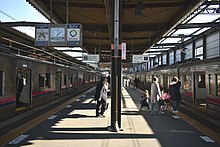Kitano train station
| Kitano ( 北野 ) | |
|---|---|
|
Reception building (April 2013)
|
|
| Data | |
| Location in the network | Separation station |
| Platform tracks | 4th |
| abbreviation | KO33 |
| opening | March 24, 1925 |
| location | |
| City / municipality | Hachiōji |
| prefecture | Tokyo |
| Country | Japan |
| Coordinates | 35 ° 38 '40 " N , 139 ° 21' 16" E |
| Height ( SO ) | 96 m TP |
| Railway lines | |
|
Closed: |
|
| List of train stations in Japan | |
The Kitano Station ( Jap. 北野駅 , Kitano-eki ) is a station on the Japanese island of Honshu . It is operated by the Keiō Dentetsu railway company and is located in Tokyo Prefecture in the area of the city of Hachiōji .
links
Kitano is a separation station on the Keiō Line that connects Shinjuku with Keiō-Hachiōji . From this, the Keiō Takao line branches off to Takao and Takaosanguchi . Both belong to the Keiō Dentetsu railway company . All local, express and express trains stop in Kitano, making the station one of the most important of the entire Keiō route network. Up to 14 trains run eastwards every hour to Shinjuku in central Tokyo . In a westerly direction there are six or seven trains every hour to Keiō-Hachiōji or to Takaosanguchi.
There are several bus stops on the north and south sides of the station. These are served by over a dozen lines of the Keiō Bus Minami and Hachibus companies.
investment
The station stands on the northern edge of the Uchikoshimachi district on a viaduct and faces east to west. It has four tracks on two roofed, slightly curved central platforms . The station building is located under the viaduct and is accessible from both sides. Elevators and escalators lead up to the distribution level on the first floor and to the platforms on the second floor. There is also a pedestrian connection on the first floor from the north to the south side of the station without having to pass the platform barriers. Integrated into the station is the Keio Retnade shopping center ( 京 王 リ ト ナ ー ド ), which, like the railway company, belongs to the Keio Group . It is Retnade a portmanteau word from the Spanish Retoño (Scion) and the French promenade .
In the 2018 fiscal year, an average of 23,099 passengers used the station every day.
Tracks
| 1/2 | ▉ Keiō Takao line | Takao • Takaosanguchi |
| ▉ Keiō line | Keiō-Hachiōji | |
| 3/4 | ▉ Keiō line | Takahatafudō • Fuchū • Chōfu • Meidaimae • Shinjuku |
history
The Gyokunan Tetsudō , a subsidiary of the railway company Keiō Denki Kidō (today Keiō Dentetsu ) opened on March 24, 1925 the line between Fuchū and Higashi-Hachiōji (today Keiō-Hachiōji ), including the Kitano station. On 1 December 1926, went Gyokunan tetsudō into its parent company, whereupon the west of Fuchū in Cape gauge (1,067 mm) moved distance mm 1372 umgespurt was. To develop the Musashi Imperial Cemetery , the Keiō Goryō line branching off in Kitano was created a few years later and went into operation on March 20, 1931. However, this had to be stopped on January 21, 1945, because the government considered the line to be "not urgent" and ordered the dismantling of the facilities in order to use them elsewhere.
In the early 1960s, the Keio Group decided to open up the emerging housing estates in the south of Hachiōji with a new railway line. For this purpose, she rebuilt part of the route of the Goryō Line and extended it under the name Keiō Takao Line to Takaosanguchi at the foot of Mount Takao . The line, which also begins in Kitano, was opened on October 1, 1967. At the end of the 1980s, the originally ground-level station was converted into an elevated system; the work was completed February 29, 1992.
Adjacent train stations
|
←
|
Lines |
→
|
||
|---|---|---|---|---|
| Naganuma |
Keiō Dentetsu |
Keiō-Hachiōji | ||
| Beginning |
Keiō Dentetsu |
Keiō katakura | ||
| Beginning |
Keiō Denki Kidō |
Keiō katakura | ||
Web links
- Keiō Dentetsu station information (Japanese)
Individual evidence
- ↑ 京 王 リ ト ナ ー ド 東 府中. Keio Ekichika, 2020, accessed February 16, 2020 (Japanese).
- ↑ 1 日 の 駅 別 乗 降 人員. Keiō Dentetsu , 2018, accessed February 16, 2020 (Japanese).
- ↑ a b Keiō Dentetsu (Ed.): 京 王 ハ ン ド ブ ッ ク 2016 . (Keiō Handbook 2016). Tama 2016.


